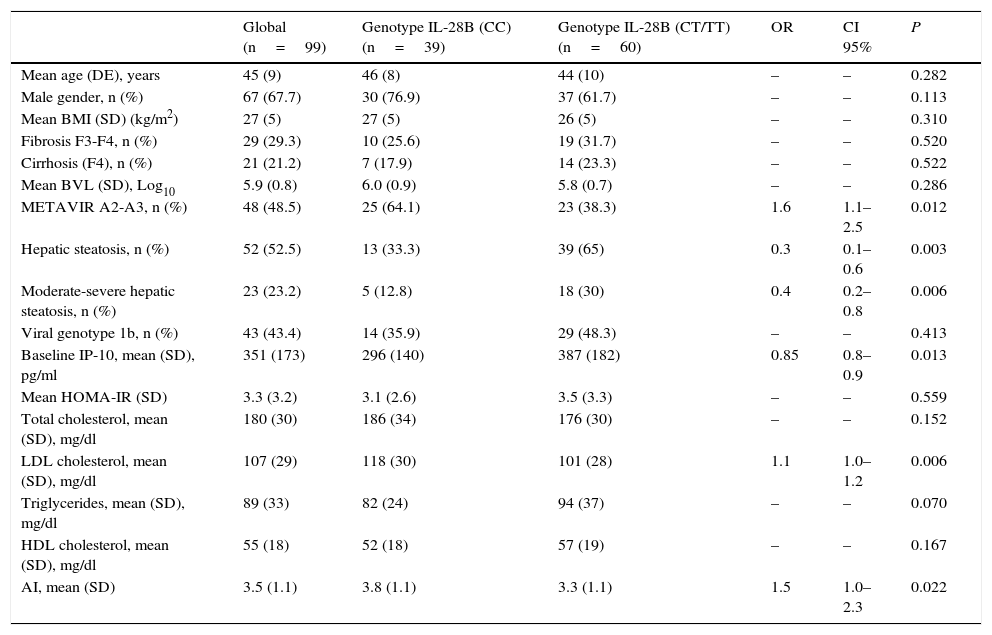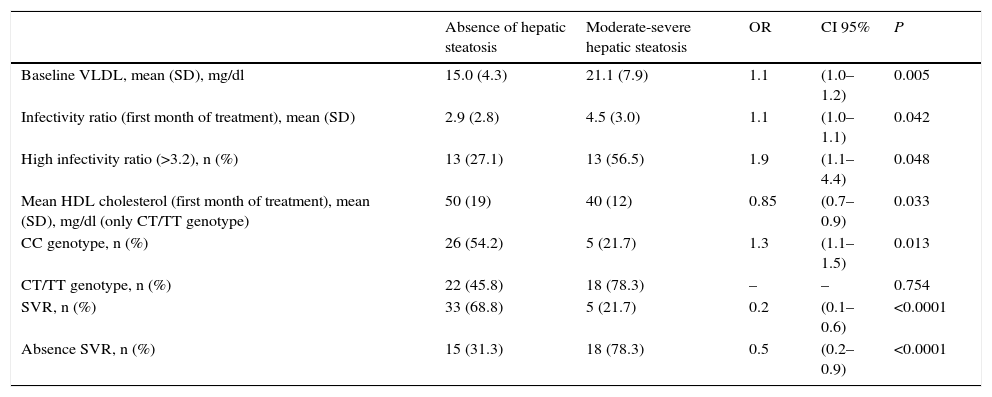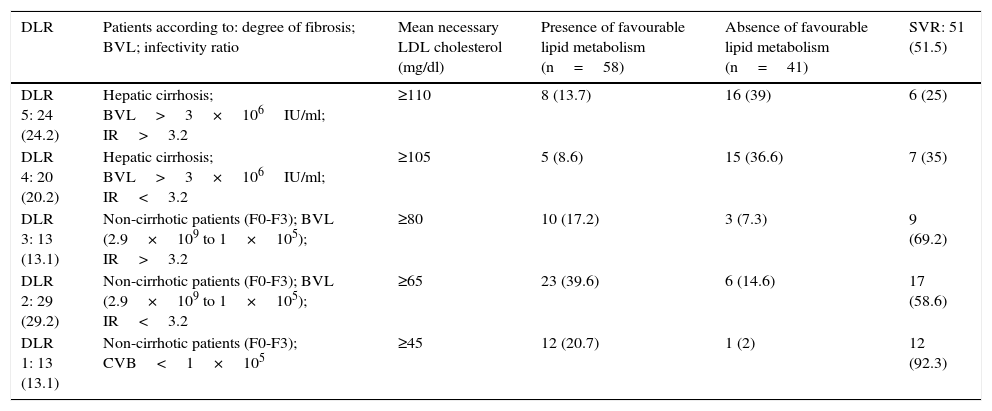We analysed baseline and kinetic characteristics of lipid metabolism during the first month of bitherapy in patients with chronic hepatitis C genotype 1 (CHC-1).
Patients and methodsA longitudinal, prospective study including 99 naïve CHC-1 patients with liver biopsy who were treated with bitherapy. Our patients were assigned to one of the 5 different “degrees of lipid requirement” that we established depending on the degree of liver fibrosis, baseline viral load and infectivity ratio (ratio between the median level of triglycerides and high density lipoproteins-cholesterol during the first month). The goal was to achieve “a favourable lipid metabolism” (FLM) by establishing a necessary minimum level of low density lipoproteins (LDL)-cholesterol during this period for each one of them. We also analysed the relationship with the rate of sustained virological response.
ResultsPatients with liver fibrosis F3-F4 who had higher baseline levels of LDL-cholesterol achieved higher rates of sustained virological response. Those patients who had a lower value of infectivity ratio and median levels of LDL-cholesterol during the first month of bitherapy also achieved higher rates of sustained virological response: SVR group 100 (23) mg/dl against non-SVR group: 89 (28) mg/dl; odds ratio 1.1; 95% confidence interval (1.0–1.2); P<0.05, these differences being more significant for genotype IL-28B-CC (P=0.013). Patients with sustained virological response had higher rates of FLM.
ConclusionsNot every patient with CHC-1 has the same lipid kinetics during the first month of bitherapy, and it is necessary to achieve a sustained virological response and/or a FLM to keep higher plasma levels of LDL-cholesterol during this period. Those subjects without FLM could benefit from statins.
Valorar el metabolismo basal y cinético de las lipoproteínas durante el primer mes de biterapia en pacientes con hepatitis crónica C genotipo 1 (HCC-1).
Pacientes y métodosEstudio longitudinal, prospectivo, que incluyó 99 pacientes HCC-1 naive, biopsiados y tratados con biterapia. Clasificamos a nuestros pacientes en 5 niveles de exigencia lipídica, según el grado de fibrosis hepática, carga viral basal y ratio de infectividad (cociente entre concentraciones medias de triglicéridos y colesterol unido a lipoproteínas de alta densidad durante el primer mes), estableciendo para cada uno de ellos, durante este período, una concentración media mínima necesaria de colesterol unido a lipoproteínas de baja densidad (colesterol LDL) para que el paciente alcanzara un «metabolismo lipídico favourable» (MLF), y valoramos su relación con las tasas de curación.
ResultadosAlcanzaron mayores tasas de curación aquellos pacientes con fibrosis F3-F4 que presentaron mayores concentraciones basales de colesterol LDL, así como aquellos que consiguieron mantener durante el primer mes de biterapia una ratio de infectividad menor de 3,2 y mayores concentraciones medias de colesterol LDL: media (DE) de 100 (23) mg/dl en «curados» frente a 89 (28) mg/dl en «no curados», odds ratio 1,1, intervalo de confianza del 95% (1,0–1,2) (p<0,05), siendo más significativas estas diferencias en los genotipos IL-28B-CC (p=0,013). Aquellos que alcanzaron la respuesta virológica sostenida presentaron mayores tasas de MLF.
ConclusionesNo todos los pacientes con HCC-1 van a presentar durante el primer mes de tratamiento una cinética lipídica favourable, siendo necesario para curarse y/o alcanzar un MLF mantener durante este período unas concentraciones plasmáticas medias de colesterol LDL mayores. Aquellos con ausencia de un MLF podrían beneficiarse del uso de estatinas.












